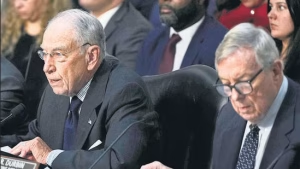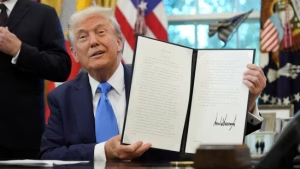Washington D.C. – In a significant development that could profoundly impact thousands of Indian professionals working in the United States, bipartisan lawmakers in the US Senate have introduced comprehensive legislation targeting the H-1B and L-1 visa programmes. The H-1B L-1 Visa Reform Act, proposed by Republican Senator Chuck Grassley and Democratic Senator Dick Durbin, aims to fundamentally reshape how American companies hire foreign workers.
Key Provisions of the H-1B L-1 Visa Reform Legislation

The H-1B L-1 Visa Reform bill introduces sweeping changes designed to restrict access to these crucial work visa programmes. The legislation proposes new wage and recruitment guidelines for employers, specifically prioritizing H-1B visas for workers with STEM (Science, Technology, Engineering, and Mathematics) degrees. Additionally, the bill significantly increases penalties for employers who violate wage requirements.
According to the senators, the primary objective of this H-1B L-1 Visa Reform initiative is to “target visa fraud and abuse” while providing enhanced “protections for American workers.” This legislative push comes amid growing concerns about foreign worker programmes displacing American employees.
Bipartisan Support Despite Political Divisions
Senator Dick Durbin articulated the rationale behind the H-1B L-1 Visa Reform bill in a strongly worded statement: “Major companies are laying off thousands of American workers while filing thousands of visa petitions for foreign workers at depressed wages and poor working conditions. Congress must step in to protect American workers and fix our broken immigration system. Senator Grassley and I will work to make this bipartisan bill the law of the land.”
The bipartisan nature of this proposal is noteworthy, as immigration reform has traditionally been a contentious issue dividing Democrats and Republicans. However, concerns about protecting American jobs appear to have created common ground for this H-1B L-1 Visa Reform initiative.
Timing and Context: Part of Broader Crackdown

The introduction of the H-1B L-1 Visa Reform bill comes just weeks after President Donald Trump announced a dramatic $100,000 fee for H-1B visa applications. The White House justified this unprecedented fee hike by citing “systemic” abuse of the H-1B visa programme, a move expected to make foreign hiring economically unviable for many companies.
US immigration agencies have simultaneously announced plans to restructure the H-1B visa lottery system to favor higher-paid workers. Furthermore, the US Department of Labour launched Operation Firewall, an aggressive enforcement effort specifically designed to crack down on fraud and misuse of the H-1B programme.
These coordinated policy decisions, culminating in the H-1B L-1 Visa Reform bill, signal a comprehensive approach to restricting foreign worker access to the American labor market.
Impact on Indian Professionals and Companies
The H-1B L-1 Visa Reform legislation will disproportionately affect Indian professionals, who constitute over 70% of approved H-1B visa recipients. Thousands of Indian workers have historically used the H-1B programme as a pathway to work and eventually settle in the United States since its current form was introduced in 1990.
Indian companies like Infosys and Tata Consultancy Services rank among the top 10 sponsors of H-1B visas, making them particularly vulnerable to these changes. The L-1 visa programme, used by multinational companies including Indian IT services firms to transfer managers and executives from foreign branches to related US offices, will face equally stringent restrictions.
Also Read: US Govt Shut Down: Explosive Trump-Democrat Clash Triggers Costly Funding Crisis
Legal Expert Analysis: Increased Compliance and Costs
Nicole Gunara, Principal Immigration Attorney at Manifest Law, provided detailed analysis of how the H-1B L-1 Visa Reform bill would function in practice: “These changes would increase compliance requirements and likely make H-1B hiring more expensive, particularly for companies that have relied on lower wage levels or contract-based staffing.”
Regarding L-1 visas specifically, Gunara explained that the H-1B L-1 Visa Reform bill “closes existing gaps by limiting outplacement, raising oversight standards, and adding wage and displacement safeguards.” She noted that these restrictions will make L-1 visa usage considerably more difficult, pushing companies toward traditional, direct employment models.
Historical Context: Low Success Rate for Immigration Bills
Despite the fanfare surrounding the H-1B L-1 Visa Reform proposal, historical data suggests caution about its prospects. Gunara emphasized a sobering statistic: “Just 5% of more than 300 immigration bills proposed between 2015 to 2024 became law, so this is a very early stage.”
Most immigration reform legislation introduced in US Congress has failed over the last decade, raising questions about whether this bill will overcome the legislative hurdles that have defeated similar proposals. The complex nature of immigration policy, combined with partisan gridlock on most issues, suggests the path to enactment remains uncertain.
Understanding the H-1B Programme Background
The H-1B visa programme was introduced in 1990 as a pathway for workers in specialty occupations to fill crucial shortages in the US economy. The visa is granted for an initial period of three years, with the possibility of a three-year extension, allowing a maximum stay of six years.
This programme has been instrumental in allowing American companies to access global talent, particularly in technology sectors where skill shortages have been persistent.
What Happens Next?
While the H-1B L-1 Visa Reform bill represents a significant legislative effort, its ultimate fate remains uncertain. Immigration lawyers advise affected professionals and companies to monitor developments closely while preparing for potential compliance requirement increases. The combination of this legislation with existing Trump administration policies suggests that regardless of the bill’s passage, the environment for foreign workers in America is becoming increasingly restrictive and expensive.

